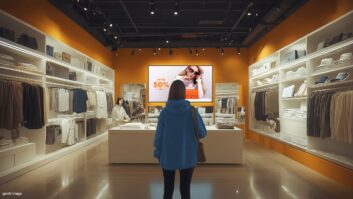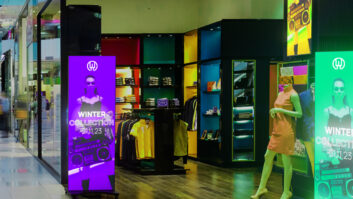Every so often a crisis situation serves to amplify or accelerate an existing trend or societal shift. That has certainly proven to be the case with retail and Covid-19, with the pandemic heightening the move away from high streets and shopping centres towards online sales. In the UK total online sales grew by 36% in 2020 year-on-year (source: IMRG Capgemini Online Retail Index), and comparable rises have been widely reported elsewhere.
All of which poses serious questions for physical stores as lockdown conditions begin to recede. Various approaches to reviving the sector – from a new generation of local markets to increased ‘digital convergence’ between the in-store and online experiences – have been discussed, and will doubtless be the subject of much experimentation in the months ahead.
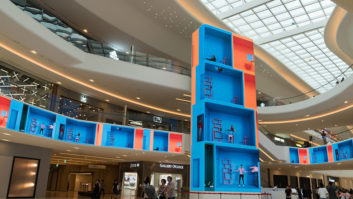 At present, it’s arguable that digital signage has never been more critical for its role in – as Ben Phelps, industry development director retail at LED display solutions company Absen, describes it – “bringing reassurance to customers with responsive health & safety and guidance messages; something that will certainly help retailers reassure customers in the months ahead.”
At present, it’s arguable that digital signage has never been more critical for its role in – as Ben Phelps, industry development director retail at LED display solutions company Absen, describes it – “bringing reassurance to customers with responsive health & safety and guidance messages; something that will certainly help retailers reassure customers in the months ahead.”
Matthew Rubin, senior market analyst at specialist research company Futuresource Consulting, anticipates continued take-up of new LED, LCD and projection solutions in retail, as well as ‘merged’ multi-display technology installations: “For certain situations, it makes sense to use a combination of multiple display technologies to get the best out of each. Retail signage is where most of this activity is expected, as retailers look for ways to create experiential shopping trips to draw consumers back to the high street.”
And whilst touch-based interaction with displays is likely to take a back-seat for a while due to Covid-19, there are still plenty of opportunities to develop cohesive digital experiences that ensure – in the worlds of Phelps – “the experience in-store is an asset – not a burden.”
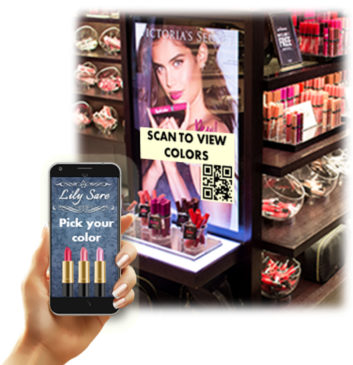 Despite the abundant challenges of the past year, there is a view that the proven value of digital communication in securing the interest and loyalty of customers has somewhat insured related visual technologies against adversity – even when viewed in the context of retailers that were planning to limit their non-digital footprints before the pandemic.
Despite the abundant challenges of the past year, there is a view that the proven value of digital communication in securing the interest and loyalty of customers has somewhat insured related visual technologies against adversity – even when viewed in the context of retailers that were planning to limit their non-digital footprints before the pandemic.
“To compete [pre-crisis with online sales] retail was adapting to make the customer experience more engaging and the use of digital display technology was increasing,” says Jon Raines, end user account manager, Sharp NEC Display Solutions, whose latest launches include the MESSAGE series of large-format displays. “The simple trends were LCD-based displays migrating to dvLED [Direct View LED signage] technology for larger, more complex displays and the increasing requirement for lower-cost digital signage. What was once seen as complex and costly has been simplified. Digital signage was also expected to deliver more than content, with marketing analytics data being highly valuable to retailers and DOOH [digital out of home].”
Keith Dutch, managing director – EMEA at AV solutions provider Peerless-AV, also pinpoints the recent ascendancy of dVLED: “It’s the digital display technology that every retailer wants in their store. Three years ago, dvLED was still in its infancy and now we are seeing LED video walls in all manner of creative size and configuration possibilities from fixed to wall and pop-out, ceiling suspended, wall wrap, recessed, moveable on tracks, and even concave and convex.”
Experience centres
“Many retailers were already planning on reducing the numbers of smaller stores and investing in ‘experience centres’ to combat the threat of online retailers or as part of their omnichannel strategy,” remarks Phelps. “Digital signage is a significant aspect of these centres, so there is a willingness – as we’ve seen through our work with international retailers throughout this time – to invest in LED.”
James Morris-Manuel, EMEA managing director at immersive 3D specialist Matterport, explains that retail and hospitality industries were already starting to adopt omnichannel strategies and explore AR/VR interactive experiences pre-pandemic. In retail specifically, he adds, discussion focused around the move from “brick to click”, but many tech-first retailers had visions beyond the more transactional e-commercial experience.
“Our research shows that the majority of consumers are interested in 3D experiences, with 63% of respondents stating that they felt a virtual store would provide a more exciting experience than traditional online shopping. As a result, retailers are already exploring AR/VR shopping as a way to achieve this.”
Requirement solutions
While all of these trends are expected to continue post-pandemic, it would be strange if they had not been affected to some degree by recent events. Hence it is apparent that – at least for the foreseeable future – there is going to be an emphasis by vendors on solutions that can cater to immediate requirements, such as safety messaging, as well as more transformative, longer-term ambitions. Awareness of in-store technology among consumers is also expected to be more acute.
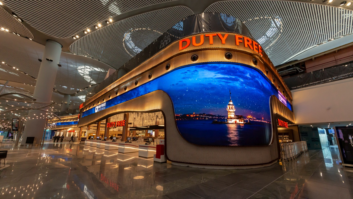 Lee Dent is AV sales head at BenQ UK, whose retail range includes store space-optimising Stretch Displays and Pantone validated digital signage displays. Dent remarks: “As people return to the high street after the last lockdown, they will be looking to see how spaces have changed to accommodate their post-pandemic needs,” he says. “Those that have evolved with dynamic messaging and immersive spaces to entice people in and provide social-led experiences will see the benefits. We anticipate the conversations we’re having now are just the beginning of what’s to come for what can be an exciting period of evolution in retail.”
Lee Dent is AV sales head at BenQ UK, whose retail range includes store space-optimising Stretch Displays and Pantone validated digital signage displays. Dent remarks: “As people return to the high street after the last lockdown, they will be looking to see how spaces have changed to accommodate their post-pandemic needs,” he says. “Those that have evolved with dynamic messaging and immersive spaces to entice people in and provide social-led experiences will see the benefits. We anticipate the conversations we’re having now are just the beginning of what’s to come for what can be an exciting period of evolution in retail.”
Sharp/NEC’s Entrance Flow Management dynamic customer counting and communication solution is one example of a manufacturer addressing an “immediate need” within retail. Raines explains: “Designed to help keep staff and shoppers safe by monitoring and controlling the flow of people entering and exiting an area, visitors are alerted once capacity has been reached, in order to limit congestion and aid social distancing. Through collaboration with Intuiface and Nexmosphere, and utilising the NEC V Series Brightsign Bundle, the complete Entrance Flow Management is an all-in-one solution providing retail systems integrators with a customisable, ready-to-install solution.”
Cost-effective
Tim Matthews, senior B2B product manager at visual solutions provider Vestel, observes: “Businesses in these sectors will be looking for cost-effective solutions to install in their venues while they recover from the results of the pandemic. We are thinking of the current needs of businesses with the ranges we are launching, having recently introduced the Q Series family of affordable ELED displays. AV solutions also need to be versatile as businesses in these sectors adapt to the changing regulations and ‘new normal’.”
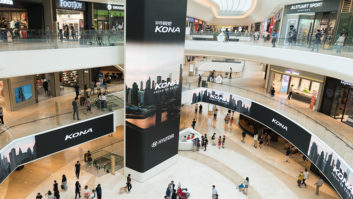 One inevitable consequence of the new normal is that touch-based interactivity is likely to be sidelined for some time to come – meaning that customers’ own devices will assume a greater role. Jeff Hastings, CEO of BrightSign, comments: “We are seeing a trend in solutions that look to reintroduce interactivity into the shopping experience without the need for physical interaction. Demand for these systems may have been accelerated by the pandemic, but they will certainly be here to stay.”
One inevitable consequence of the new normal is that touch-based interactivity is likely to be sidelined for some time to come – meaning that customers’ own devices will assume a greater role. Jeff Hastings, CEO of BrightSign, comments: “We are seeing a trend in solutions that look to reintroduce interactivity into the shopping experience without the need for physical interaction. Demand for these systems may have been accelerated by the pandemic, but they will certainly be here to stay.”
Hastings points to the rise of QR technology as one alternative route to physical touch, with BrightSign’s own BrightLink touchless solution allowing customers to scan a QR code and transfer control of an interactive digital signage experience to their own devices – after which they can then browse or interact with content as they normally would. He adds: “The interface lets customers access detailed product information, discount coupons, wayfinders and even interactive product demonstrations, with no app or internet connection required. The system also offers a wide range of engagement options – for example, once a customer connects with a display, they can then be invited to opt into the store’s loyalty programme or even complete a sale via the retailer’s mobile e-commerce platform.”
Intelligence driven
Jørn Olsen, head of marketing & analytics at ZetaDisplay Norway, predicts an uplift in another area of customer interaction involving the integration of gaming and digital signage. “Gamification to encourage dwell-time, or in areas where people are prepared to wait such as in queue lines, is an incredibly popular trend,” he says. “We will see this gaining further traction as customers return to retail spaces and are looking to socialise with friends and engage in ‘shopping’, rather than just ‘buying’. We have recently teamed up with a start-up called AirConsole to bring high-end gaming into the digital signage world. Using their mobile devices, customers can interact with displays using their devices as the controller for multiple experiences.”
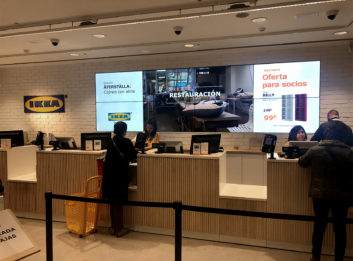 Meanwhile, Dutch anticipates a growing role for Artificial Intelligence in content/customer interaction, driven by software such as VSBLTY, which can provide customer awareness and information via AI-driven facial recognition. “A scenario could be a shopper entering the fragrance section of a department store and the camera within the display over the counter identifying them and analysing their gender and age range. Then based on the data the display might advertise a particular perfume or aftershave,” he says.
Meanwhile, Dutch anticipates a growing role for Artificial Intelligence in content/customer interaction, driven by software such as VSBLTY, which can provide customer awareness and information via AI-driven facial recognition. “A scenario could be a shopper entering the fragrance section of a department store and the camera within the display over the counter identifying them and analysing their gender and age range. Then based on the data the display might advertise a particular perfume or aftershave,” he says.
For Matterport, 3D modelling techniques that can presage the development of more immersive environments long-term will remain pivotal – although they are also finding a more immediate application. Notes Morris-Manuel: “Digital-twin technology creates an accurately scaled 3D model of a space which can be used to map customer flows, factor in space requirements, and include details such as sanitation stations and other pandemic-related considerations.
New developments
With more complex in-store technologies in play, and the movement towards a closer coordination of visuals with overall brand identities, it’s not surprising that there are also plenty of developments “behind the scenes”, to quote Dent. Hence the increasing importance of content management software – such as BenQ’s X-Sign – that can process, store and deliver content in a consistent manner.
nsign.tv, a Spanish company focused on software for the digital transformation of physical spaces, is well-positioned to chart the evolution of integrated control and communication requirements. Discussing the latest version of nsign.tv’s omnichannel communication platform, CTO Germán Talón remarks: “This platform allow users in a user-friendly and intuitive way to store, organise, programme and play digital content in a measurable, centralised way on any screen. It can integrate flexibility into a scalable digitalisation project through AI, Big Data and IOT to create differential experiences with customers and employees in any physical space.”
 There is little doubt that the retail sector will remain challenging for some time to come and there may well be further store closures and casualties. But for those operators who can invest it is clear that visual technologies will play a big role in bringing customers back into store – although they will need to be deployed as part of well-defined and coherent strategies to get the best results.
There is little doubt that the retail sector will remain challenging for some time to come and there may well be further store closures and casualties. But for those operators who can invest it is clear that visual technologies will play a big role in bringing customers back into store – although they will need to be deployed as part of well-defined and coherent strategies to get the best results.
Last word to Talón, who observes: “Digital signage will play a very important role in restoring the health of the retail sector and not only as a supporting actor but as a real protagonist. Nevertheless, it is important that when you design a digital signage system, however simple or complex, it is endowed with a coherent sense and strategy and that the people who manage it exploit as much as they can obtain from it. Without planning, strategy or information analysis, this system will be like any other technology system: a very expensive way to generate frustration after poorly managed expectations.”
It boasts new digital tools designed to allow integrators to manage design and workflow, while enhanced cloud connectivity allows for remote support, all with minimal disruption for homeowners.
“The addition of QSX purposefully makes HomeWorks easier to design, install, activate, program, and service,” says Detmer. “Client expectations continue to rise, and become more complex, with a growing number of other smart devices to integrate with and the standard of home technology and its software always improving.”
“The QSX processor is powerful, with enhanced memory capacity, greater use of the cloud and secure connection to third-party products. This makes the installation process simpler for smart home professionals, and therefore quicker and stress-free for their clients. Essentially, smart home professionals can work with confidence that their project data is safely stored, and that their clients will always have access to the latest capabilities.”



